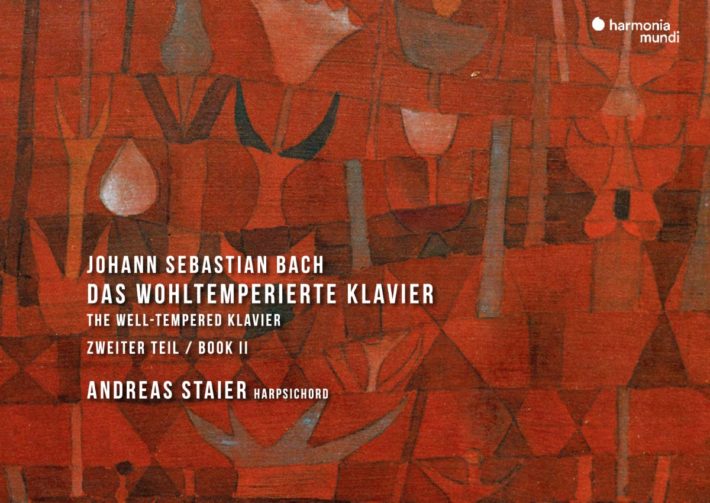A nearly 20-year gap spans the compositions of the two books of the Well-Tempered Clavier; the conception of the second was not without its challenges in terms of originality–as well as Bach’s decision to limit his fugues to only 3 and 4 voices this time around. The result is nonetheless stunning: an entirely distinct retraversal through the key cycle shows his innovation in drawing upon different musical styles of his time. Andreas Staier, in his latest recording, chooses to focus on this latter volume, which for any performer, also sets a high artistic and technical bar.
The C major Prelude brings out all the pomp and circumstance with its commanding presence: the thirty-second note patterns are tight (almost perceptible as ornaments) which helps reveal the harmonic structure of the theme. The bass tones of Staier’s harpsichord (the 2004 Sidey/Bal copy of the 18th century Haas that he also used on his 2010 Goldberg recording) are amplified via a doubling mechanism. The resulting sound has a vigour that can’t be ignored, for better or worse. Its power is sweeping and reminiscent of an organ but can also create a melange of sonorities that detracts from the upper voices. For comparison, Masaaki Suzuki, who has recorded both books on BIS, uses a less robust 1982 Kroesbergen and also takes a slightly less urgent angle to the rhythmic patterns. His interpretation ultimately pays more dividends: despite the lighter timbre, the tone and style are just as effective in communicating the work’s character–but with a more satisfying clarity.
To my dismay, I realized more than a few instances where the instrument becomes a frustrating hindrance. In the C major Fugue, the heavy tone, especially when paired with the performer’s well-meaning (but slightly dogged) approach, jumbles the intricacies of Bach’s contrapuntal textures. The F-sharp major Prelude (Disc 2, track 1) starts off promisingly, with a booming 3-dimensional sound that really brings to life the French Overture style. But when the same magnitude of density carries on for an extended duration, it quickly becomes overwhelming. A version more inviting perhaps is Robert Levin’s (hänssler, 2000): the jubilant nature is derived through precise dotted rhythms, but the sixteenth notes have more dryness to successfully counterbalance the work’s ongoing intensity.
Certain sets, like the F minor (Disc I, tracks 23-24) fare better. Staier shows care in creating a smooth legato throughout and the repeats go beyond the mere addition of a few more ornaments; in some cases, a few tasteful adjustments of melodic patterns pique our ears. The Fugue is brisk and high-spirited, serving a nice contrast to the sostenuto of the Prelude.
Related Classical Music Reviews
- Review: Bach – Complete Keyboard Edition, Vol. 3 – Benjamin Alard
- Review: Bach – English Suites – Masaaki Suzuki, Harpsichord
- Review: Bach – WTC Book II (Excerpts) – Piotr Anderszewski
The A minor Prelude (Disc 2, track 15) shows some experimentation on Staier’s part in exploring some interesting sonoric capabilities of the instrument. He plays the entire right hand line one octave higher in the first repeat; this different registration brings tones that are simultaneously more delicate and salient than what we’ve heard elsewhere. The contrast between the high treble and low bass also delineates a clear conversation between the voices. The Fugue, with its unapologetic crispness, exudes an austere character, though I do prefer Rosalyn Tureck’s (from her 1981 harpsichord recital at the Metropolitan Museum of Art). Where Staier again treats some of the faster notes almost as ornamental sweeps, Tureck plays with more evenness. This lets us appreciate the seamless continuity of the lines and patterns as they bridge different voices.
While the liner notes could use a better visual layout for an easier read, they shed interesting light on Book II’s compositional genesis and its relationship to some of Bach’s other defining compositions. As for the sound engineering, it sadly misses the mark. Yes, it convincingly portrays the instrument as a force to be reckoned with–but it doesn’t give due diligence to the element of balance, which if better managed, would have enhanced distinctions of different registers and manuals.
The album no doubt shows Staier’s familiarity and confidence with a significant set of challenging works. But as far as an insightful period instrument performance goes, other renditions might do a little more for the listener.

The Well-Tempered Clavier, Book II
Andreas Staier – Harpsichord
Harmonia Mundi, CD HMM90268283
Recommended Comparisons
Read more classical music reviews or visit The Classic Review Amazon store
Follow Us and Comment:
[wd_hustle id=”HustlePostEmbed” type=”embedded”]











